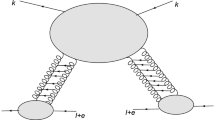Summary
A fit to finite-energy sum rules for the amplitudeB (−) in pion-nucleon scattering at various momentum, transfers in terms of a dominant ϱ trajectory provides much more satisfactory results if the Born-term contribution is subtracted from the sum rules. This result may give an, indication in favour of what could be called «three-componennt duality», in which, besides the well-known correspondence between pomeron and diffraction, and between moving Regge poles and resonances, there is a further correspondence between nonstandard singularities (e.g. fixed poles) and Born terms.
Riassunto
Le regole di somma a energia finita per l’ampiezzaB (−) nella diffusione pione-nucleone (a diversi impulsi trasferiti), se interpretate in termini di una traiettoria di Regge dominante (quella del ϱ), danno risultati molto più soddisfacenti quando il contributo del termine di Born viene sottratto da esse. Questo risultato potrebbe fornire un’indicazione in favore di una cosiddetta «dualità a tre componenti», in cui, oltre alla nota corrispondenza tra il pomerone e la diffrazione, e tra i poli di Regge mobili e le risonanze, c’è un’ulteriore corrispondenza tra singolarità di tipo non standard (come, per esempio, i poli fissi) e i termini di Born.
Similar content being viewed by others
References
E. Ferrari andG. Violini:Nuovo Cimento A,69, 375 (1970).
A. Garcia andG. Violini:Lett. Nuovo Cimento,2, 826 (1971).
H. Harari:Phys. Rev. Lett.,20, 1395 (1968).
L. K. Chavda:On dynamic, origin of fixed Regge poles in weak, electromagnetic, and strong interactions, University of Alberta preprint (1971). See alsoL. K. Chavda:Nuovo Cimento A,8, 722 (1972).
C. Ferro Fontà, N. M. Queen andG. Violini:Riv. Nuovo Cimento,2, 357 (1972).
R. Dolen, D. Horn andC. Schmid:Phys. Rev.,166, 1768 (1968).
W. Langbein:Lett. Nuovo Cimento,22, 85 (1978).
H. Hecht, P. Kroll andH. P. Jakob:Nucl. Phys. B,71, 1 (1974).
R. Ayed:Analyse en déphasages de la diffusion élastique pion-nucléon, du seuil à l’énergie de 2.5 GeV, Saclay, preprint CEA-N-1921 (1976).
G. Höhler, F. Kaiser, R. Koch andE. Pietarinen:Physics Data 12-1 (Karlsruhe, 1979).
Author information
Authors and Affiliations
Additional information
To speed up publication, the authors of this paper have agreed to not receive the proofs for correction.
Rights and permissions
About this article
Cite this article
Arci, E., Ferrari, E. & Violini, G. An indication for «three component» duality in finite-energy sum rules for pion-nucleon scattering. Nuov Cim A 57, 77–84 (1980). https://doi.org/10.1007/BF02832948
Received:
Published:
Issue Date:
DOI: https://doi.org/10.1007/BF02832948



